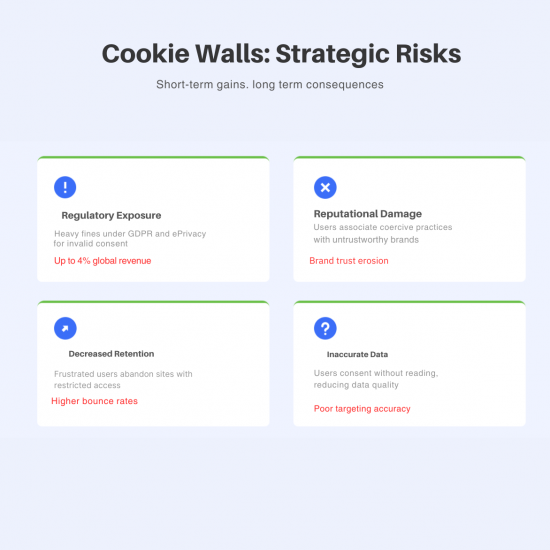Have you deployed a cookie wall on your website without revisiting the legal risks? Many businesses rely on cookie walls to drive consent rates, but doing so may affect compliance and user trust. With regulatory scrutiny increasing, companies must ask: Is the data gain worth the compliance risk?
This blog will break down what a cookie wall is, how it aligns or conflicts with global privacy laws like the GDPR, and what businesses can adopt as compliant and user-respecting alternatives. Continue reading!
A cookie wall is a mechanism that blocks access to a website unless the user consents to cookies. This model is designed to maximise data collection by minimising opt-outs.
In contrast, a cookie consent wall allows users to access content even if they reject non-essential cookies. The key distinction is that cookie consent walls prioritise regulatory compliance by offering real choices without restricting access.
Cookie walls are frequently seen in either of two forms:
For businesses, the cookie wall may seem like an efficient way to boost analytics and ad tracking, but this comes with serious compliance risks.
To comply with the General Data Protection Regulation (GDPR), businesses must ensure user consent satisfies four strict legal conditions:
In May 2020, the European Data Protection Board (EDPB) explicitly stated that cookie walls do not result in valid consent because the user does not have a real choice. Businesses that implement such walls risk violating Article 7 of the GDPR, which outlines the conditions for valid consent.
Additionally, the ePrivacy Directive, which works in tandem with the GDPR, restricts the use of tracking technologies unless the user has provided prior consent that is freely given. A cookie wall fails to meet this standard because it forces consent as a precondition for access.
UK regulators, including the Information Commissioner’s Office (ICO), align with this interpretation. Consent must be non-conditional, and access to content cannot be made contingent upon cookie acceptance.

Using cookie walls might offer short-term data collection benefits, but long-term risks are far greater:
In 2024, multiple EU-based companies received warnings and investigations for enforcing cookie walls that did not meet regulatory standards.
To maintain GDPR compliance and still collect actionable data without compromising user experience, businesses should consider these effective and legally compliant alternatives.
These alternatives are more aligned with GDPR standards and better for long-term trust and engagement.

For businesses, designing a compliant cookie banner is essential. Here’s what to keep in mind:
An AI-powered consent management platform like Seers AI can help automate the design of cookie banners and streamline these processes.
The cookie wall, once seen as a shortcut to user data, is now a growing liability. With clearer regulatory guidance, it’s no longer viable for businesses serious about compliance and digital trust. Instead, focus on building long-term value through transparent consent strategies that align with user rights and legal standards.
Take control of your compliance strategy today. Switch from risky cookie walls to smart, user-friendly consent with Seers AI—no coding, no legal guesswork. Protect your brand, build trust, and stay GDPR-compliant in just a few clicks.
Start Free NowA cookie wall blocks users from accessing a website unless they accept cookies. It forces consent by restricting content, typically to maximise data collection. However, this approach is legally questionable under GDPR and ePrivacy regulations, as it does not offer users a real choice, making the consent invalid in many jurisdictions.
Is using a cookie wall compliant with GDPR?
A cookie wall denies access without cookie consent, while a cookie consent wall allows access even if non-essential cookies are rejected. The latter aligns better with privacy regulations because it respects user choice. Cookie consent walls support transparency and trust, whereas cookie walls are seen as coercive and legally risky for businesses.
Cookie walls expose businesses to regulatory fines, reputational damage, and reduced user retention. Since they often violate GDPR and ePrivacy rules, businesses can face investigations and penalties. Additionally, coercive consent leads to lower data quality and harms brand trust. The short-term data gain does not outweigh the long-term compliance and ethical risks.
Alternatives include GDPR-compliant cookie banners, consent preference centres, and progressive UX models. These tools let users customise consent without blocking content, improving trust and user experience. They help maintain compliance while still collecting valuable data. Solutions like Seers AI simplify implementation by offering intelligent, user-first consent frameworks that align with evolving privacy laws.
Businesses must provide clear, non-conditional choices, use neutral language, and allow users to reject or customise cookies. Consent should be freely given, informed, specific, and easy to withdraw. Implementing category-based controls, audit logs, and ethical UX designs are key steps toward meeting GDPR and ePrivacy requirements without relying on coercive tactics like cookie walls.
 Rimsha Zafar
Rimsha ZafarRimsha is a Senior Content Writer at Seers AI with over 5 years of experience in advanced technologies and AI-driven tools. Her expertise as a research analyst shapes clear, thoughtful insights into responsible data use, trust, and future-facing technologies.
United Kingdom
24 Holborn Viaduct
London, EC1A 2BN

Seers Group © 2025 All Rights Reserved
Terms of use | Privacy policy | Cookie Policy | Sitemap | Do Not Sell or Share My Personal Information.
Let Seers AI automate your compliance setup in seconds